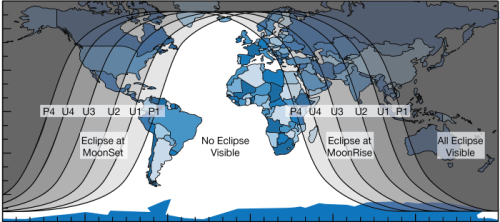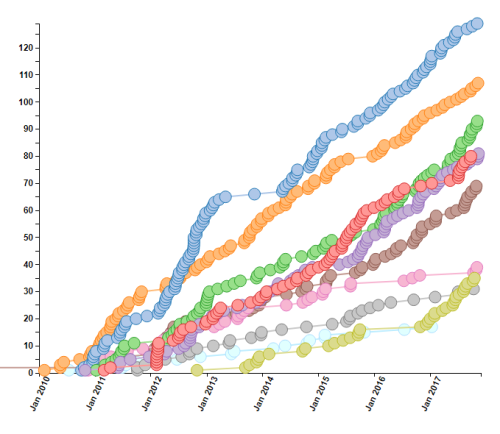Tag archives: space
Watch the super blue blood moon eclipse live

Eclipse watching: where the blood moon will be visible (Courtesy: NASA)
By Hamish Johnston
Tomorrow, people around much of the world should be able to see a lunar triple-whammy. There are two full moons this month, which is a relatively rare occurrence called a blue moon. The Moon is also near its closest approach to Earth, which means that it will loom large in the sky as a super moon.
View all posts by this author | View this author's profile
CMS publishes 700 papers, extreme data centres, flat-Earth space programme launches tomorrow

Big data: analysis of CMS papers. See Rao’s article for an interactive version (Courtesy: Achintya Rao/CMS)
By Hamish Johnston
CERN’s CMS collaboration has passed a milestone of sorts at the end of October – it published its 700th research paper. And physicists working on the giant detector on the Large Hadron Collider haven’t stopped there as the tally is now 712 and rising.
CERN’s Achintya Rao has delved into the CMS archives and has chosen his top seven papers. These include the first-ever paper about the detector, which was published in 2008 and, embarrassingly, gets the weight of the detector wrong. Rao has also put together an interactive infographic that looks at 680 papers that analyse data collected by CMS.
View all posts by this author | View this author's profile
Indian independence, Doppler effect on a train, contagious science
By Michael Banks
This week India celebrated 70 years of independence. So what better way to mark the occasion than a music video? Step forward 20 or so scientists from the Indian Space Research Organisation (ISRO), who dub themselves the Rocket Band. Over the space of 18 months, they worked feverishly to create a seven-minute music video entitled “I am an Indian”. Mostly shot on the coast of the Arabian Sea, the video features the researchers walking along the beach as well as an animation of the Indian flag being put on the surface on the Moon. “We have a lot of talent in ISRO, making rockets comes naturally to many of us while making music is tough but it is not rocket science,” aerospace engineer Shiju G Thomas told NDTV.
View all posts by this author | View this author's profile
Chicken sandwich goes stratospheric, socks for space, dressmakers have needle-sharp vision

Space sandwich: a Zinger floats high above Earth. (Courtesy: KFC)
By Sarah Tesh and Hamish Johnston
If you could put anything on a high-altitude balloon, what would it be? World View Enterprises has opted for a spicy chicken sandwich. The company plans to run balloon excursions to the stratosphere and on 21 June it will make its debut voyage carrying a Zinger sandwich from Kentucky Fried Chicken (KFC) – but with no-one on board to eat it. According to the New York Times the flight is tied in with KFC’s current space-based advertising campaign and the sandwich will spend at least four days in the stratosphere. As well as planning to charge tourists $75,000 per person for a ride, World View Enterprises says that its balloons could also be used to create an early warning system for tornadoes. (more…)
View all posts by this author | View this author's profile
Space weather: it’s all about impact
By Susan Curtis

Dangerous affair – an extreme ultraviolet image of a tangle of arched magnetic filed lines in the Sun’s corona, taken in January 2016 by NASA’s Solar Dynamics Observatory. (Courtesy: Solar Dynamics Observatory, NASA)
We all love a good disaster movie, but when it comes to real life it’s all too easy to downplay a dangerous but distant threat. Many people choose to live on active volcanoes, the citizens of San Francisco know that “the Big One” could strike at any moment, and yet they believe that the benefits of living in those locations outweigh the risk of a severe event happening in their lifetime.
The same dilemma faces the community of scientists, engineers and policy-makers who are working to understand the impacts of space weather – changes in the Earth’s environment that are largely are driven by physical processes originating from the Sun. Space weather has the potential to disrupt or even damage critical infrastructures on Earth, such as the power grids, aviation routes and communication systems that modern societies depend on, but the last notable event dates back to 2003.
That’s why Mike Hapgood, who heads up the Space Weather Group at RAL Space, part of the UK’s Rutherford Appleton Laboratory, has written a new, free-to-read Physics World Discovery ebook called Space Weather. “I thought it would be a great opportunity to highlight what space weather is really about, and to show how we are linking our scientific knowledge to a better understanding of the impacts on society,” he comments.
View all posts by this author | View this author's profile
Create films with the sounds of space
By James Dacey
Last weekend I went to a Davie Bowie tribute night at a local pub in Bath. It was a fun evening – roughly a year since the artist passed away – where local musicians played classic tracks by Ziggy Stardust, the Thin White Duke and several of Bowie’s other alter egos. One of the more surreal moments of the night was when a man in a pink suit took to the stage to play what the band called his “spaceship” – producing a whirring, repetitive electronic sound that built up to a crescendo. For a few minutes we were transported into space, just as Bowie intended with many of his memorable songs.
View all posts by this author | View this author's profile
To the stars, through adversity
 By Margaret Harris
By Margaret Harris
Space is, famously, “the final frontier”. It is also – almost as famously – “hard”. We saw this most recently in October, when the Schiaparelli lander crashed onto the surface of Mars, but throughout humanity’s nearly 60-year history as a spacefaring species, our hopes of exploring and observing the cosmos have repeatedly come up against the stiff challenge of building vessels that can survive the journey. Arguably, no other industry on Earth (or indeed off it) has rejoiced in such high “highs”, or agonized through such low “lows”.
That mix of heady dreams and harsh realities is one reason why the latest Physics World focus issue on astronomy and space science carries the tag line “To the stars, through adversity” (I’ll come to the other reason at the end of this blog post). The articles in the issue – which you can read free of charge – pay tribute to the ingenuity of the scientists and engineers involved in the challenging and rewarding practical work of exploring and observing the cosmos. Here, you can learn about the latest advances in astronomical instrumentation, get up to speed with future space missions, and familiarize yourself with recent developments in the entrepreneurial “new space” industry.
View all posts by this author | View this author's profile
Plush toys launched into space, interplanetary mining missions and more
By Tushna Commissariat
The European Space Agency’s (ESA) Rosetta spacecraft has, as of this week, spent two full years in orbit around comet 67P/Churyumov–Gerasimenko, since it reached its destination in August 2014. While Rosetta was the mothership, it also deposited its “baby” lander called Philae onto the comet’s surface in November that year. Sadly Philae was switched off in July this year. If you feel like you want to relive the excitement of the initial launch, take a look at the video above. The folks over at Design and Data, who created Rosetta’s iconic cartoons and memorabilia for ESA, launched a plush-toy version of the spacecraft into space, to see how it would fare. Watch the video to see how their “mission” played out.
View all posts by this author | View this author's profile
China’s chief Moon scientist Ziyuan Ouyang outlines lunar plans

The Moon man: Ziyuan Ouyang in his office at the National Astronomical Observatories with a lunar globe covered with images taken by Chinese craft. (Courtesy: Mingfang Lu)
By Matin Durrani in Beijing, China
I caught up this morning on the second day of my visit to Beijing with Ziyuan Ouyang, chief scientist of China’s Moon programme at the National Astronomical Observatories, which lies not far from the city’s iconic “bird’s-nest” Olympic stadium.
I’d first met Ouyang on my last visit in 2011 when the country had so far launched two lunar missions – Chang’e 1 (which orbited the Moon for 18 months before crash-landing onto the lunar surface) and Chang’e 2 (another lunar orbiter that later moved off into interplanetary space).
China’s lunar efforts have continued and Ouyang explained to me what has happened since my last visit – and what the country plans to do next.
View all posts by this author | View this author's profile
Finding innovation in space

Way to go: Carlton House Terrace. (CC BY-SA 2.0 Richard Croft)
By Margaret Harris
I have a mental block about Carlton House Terrace. This elegant little street in central London is home to several of the UK’s national academies, including the Royal Society and the Royal Academy of Engineering (RAEng), and I’m sure I’ve visited it at least half a dozen times. Yet somehow, whenever I emerge from Charing Cross underground station in the middle of Trafalgar Square, I never know which way to go next.
Fortunately, this is the 21st century, so when the usual disorientation struck me yesterday on my way to an “Innovation in Space” event at the RAEng, I simply pulled out my smartphone. Within seconds, an app told me exactly where I was (plus or minus a few metres) and how to walk from there to 3 Carlton House Terrace. Minutes later, I was safely ensconced in the seminar room, nodding in agreement as the event’s chair, Sir Martin Sweeting, explained how space-related innovations – including, ahem, the network of satellites that make up the Global Positioning System (GPS) – have become an integral part of our daily lives.
View all posts by this author | View this author's profile